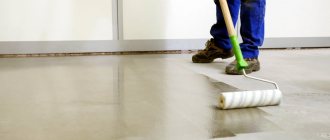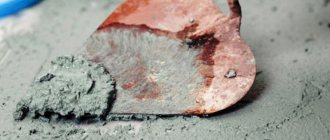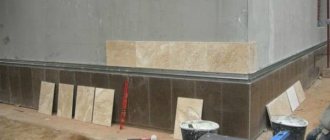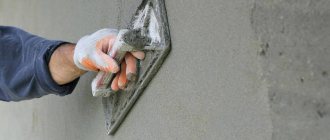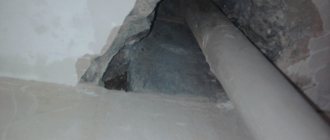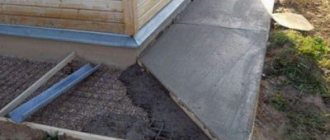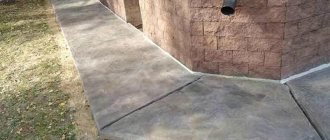Polyurethane sealant
is a viscous polymer substance that is produced on the basis of a synthetic elastomer. Sealants based on polyurethane and polymer components are new generation materials.
Their use can significantly improve the quality and reliability of waterproofing cracks, seams and the most vulnerable places on the roof: junctions, valleys, connections of individual sheets or covering elements and points of fastening of roofing materials.
Origin
In the first half of the 20th century, the question arose - “What can replace natural materials such as cork and rubber?” A cheap alternative was needed, a material whose production would use non-exhaustible resources.
The first experiments were carried out in the USA - they studied the synthesis of polyamides. The Germans went further than the Americans by synthesizing polyurethane elastomers by the interaction of diisocyanates and polyols.
As a result of numerous tests and experiments, elastic, semi-rigid, rigid and polyurethane foams were obtained. In the construction industry, elastic one-component polyurethanes (also known as sealants) and polyurethane foam have found the most widespread use.
In the European and American sealing markets, polyurethane sealants occupy a much larger share compared to silicone and thiokol-based materials.
Peculiarities
Most buyers choose polyurethane compounds because they have many positive qualities.
Let's take a look at some of them:
- Polyurethane sealant is characterized by increased elasticity. Often it reaches 100%. It is very easy to work with such a composition.
- Such mixtures boast excellent adhesion to many types of materials. They fit seamlessly onto concrete, brick, metal, wood and even glass. In addition, polyurethane-based sealants also have good self-adhesion.
- Such compositions are wear-resistant. They are not afraid of high levels of humidity or aggressive ultraviolet rays. Not every binding material can boast such characteristics.
- Guarantees excellent sealing and waterproofing of the necessary parts for quite a long time.
- Temperature changes are not scary. It can easily withstand exposure to sub-zero temperatures down to -60 degrees.
- Can be used at any time of the year. For example, it could be winter with cold ambient air. In such conditions, the sealant will still easily lie on one or another base, so repair work will not have to be postponed to a warmer period.
- Does not form smudges. Of course, this property occurs in cases where the applied layer does not exceed 1 cm in thickness.
- The composition gives minimal shrinkage after polymerization is completed.
- Polyurethane sealant is also convenient because it dries in the shortest possible time and hardens quite quickly.
- Environmental friendliness. These materials do not contain hazardous and harmful substances released under the influence of high temperatures. Thanks to this advantage, polyurethane sealants can be used without fear in furnishing residential premises - baths, kitchens.
- If the air contains moisture , then under its influence such a sealant will polymerize.
- Not subject to rust.
- Such materials are not afraid of mechanical damage.
When exposed to external influences, they quickly return to their previous shape.
It is worth noting that polyurethane-based sealant has many characteristics similar to polyurethane foam during its drying process, since it polymerizes in the shortest possible time and becomes hard.
Modern sealants contain a component such as polyurethane with a one-component structure. You can also find two-component versions in stores that boast improved sealing properties.
Flaws:
- Despite the fact that polyurethane sealants have excellent adhesion properties, in some cases they are not enough. A similar problem can be encountered if you seal structures made of certain types of plastics.
- According to experts and manufacturers , polyurethane compounds cannot be laid on substrates whose moisture level exceeds 10%. In this case, they should be “reinforced” with special primers, otherwise you simply will not be able to achieve sufficient adhesion.
- It was stated above that polyurethane compounds are not afraid of temperature changes. However, it is worth considering that prolonged exposure to temperatures of 120 degrees can lead to the sealant losing its performance.
- Few people know, but recycling polymerized sealant is an expensive and very complex operation.
Kinds
Thanks to the wide range, customers can choose the best sealant option for various conditions. Let us take a closer look at what types of such compositions exist today.
First of all, all polyurethane sealants should be divided into one-component and two-component.
One-component
This type of sealant is quite common. It is a substance that resembles a paste in consistency. It contains one component - a polyurethane prepolymer.
This adhesive-sealant boasts increased adhesion to most materials. It can be used even when working with capricious ceramic and glass bases. After laying the one-component composition on the joints, the stage of its polymerization begins.
This occurs due to exposure to moisture contained in the surrounding air.
According to experts and craftsmen, one-component sealants are recognized as one of the most convenient to use.
To obtain them, you do not need to combine different components, so the resulting quality of seams is always excellent. Similar compositions are used both for repair and construction work.
Most often they are chosen for sealing:
- various building structures;
- roof joints;
- automobile bodies;
- glass that is installed in cars.
Sealant for concrete by type of application
Each type of concrete sealant has its own specific requirements for application to the surface.
There are 3 types of applying sealant to a concrete surface:
- A type of sealant that is applied using a putty knife.
- Brush type of sealant, when it is applied using a brush.
- A pouring method of applying sealant to a concrete surface, which requires the use of a special construction gun.
Properties
Polyurethane sealants are distinguished by the fact that they have excellent strength characteristics and have a long service life.
They are not afraid of unfavorable environmental factors.
They perform well even under water, so such mixtures can be used in a variety of areas.
Polyurethane sealants adhere seamlessly to most known materials, for example:
- with brickwork;
- natural stone;
- concrete;
- ceramics;
- glass;
- tree.
When open cavities are filled with a similar composition, it forms a very neat layer resembling rubber. He is absolutely not afraid of negative external factors.
It is also worth paying attention to the fact that high-quality polyurethane sealant adheres 100% to certain substrates, regardless of their texture.
After drying, the sealant can be painted. As a result, it will not lose its useful qualities and will not undergo deformation.
Polyurethane sealant is a fairly economical material, especially when compared with different analogues. One package may well be enough to treat a considerable area.
For example, if you need to fill a joint that is 11 m long, 5 mm deep and 10 mm wide, then you will only need 0.5 liters of sealant (or 2 cartridges of 0.3 liters each).
As for the average material consumption with a seam width of 10 mm and a depth of 10 mm, it will be 1 tube (600 ml) per 6.2 linear meters.
Modern polyurethane sealants have a short drying time. However, we must not forget that this parameter is influenced by the density of the applied layer.
The polyurethane-based composition seamlessly adheres to other sealants. Thanks to this property, if the seal is damaged, the affected area can be easily repaired. As a result, the improvements will be almost invisible.
Polyurethane sealants are available in transparent and colored varieties. In stores you can find not only simple white, but also gray, black, red, yellow, blue, green and other colorful compositions.
The nuances of choosing a sealant for concrete
When choosing a sealant for a concrete surface, you should pay attention to the following points:
- An indicator of strength and hardness, because the stability of the seam and its durability depend on this.
- Hardening time of the material.
- Consumption indicator.
- The higher the adhesion level, the better the grip.
- Level of elasticity.
- How mobile the material is, this is especially worth considering for vertical work.
- Frost resistance of the material.
Consumption
Polyurethane sealants have many positive qualities, which include the cost-effectiveness of their use. Many consumers are wondering how to correctly calculate the consumption of such a composition.
Important input data in this case are the width, depth and length of the seam that needs to be sealed.
You can calculate how much polyurethane-based sealant you will need using the following simple formula: joint width (mm) x joint depth (mm). As a result, you will learn about the material requirement in ml per 1 linear meter of seam.
If you plan to form a triangular-shaped seam, then the resulting result must be divided by 2.
Sealant for concrete when ready
When ready for use, concrete sealant comes in two types:
- One-component - a sealant that is completely ready for use and does not require any manipulation.
- Two-component - a sealant that must be prepared before use, namely, mixed in a certain proportion, it is indicated on the package.
It is worth noting that, regardless of the type of readiness for use, each sealant has its own indicators of elasticity, elasticity, and setting time.
Application
Modern polyurethane sealants are used in various fields, as they are easy to work with.
Let's take a closer look at the cases in which you can't do without such adhesives:
- For indoor and outdoor work. It is often used for high-quality sealing of door and window openings.
- When installing a new window sill.
- If you need to seal the seams left between the panels, then polyurethane sealant is best suited.
- When sealing structures made of natural/artificial stone. For such work, polyurethane sealant is ideal.
- In case you need to process objects subject to slight vibration, where the filled seams may become deformed. That is why such products are used in the automotive industry. For example, they can be used to assemble and disassemble headlights and glass.
- For high-quality waterproofing of roofs , foundations and artificial reservoirs, since it does not lose its positive qualities upon contact with water.
- When assembling various pieces of furniture.
- When sealing seams and in cases where the structure is subject to constant temperature changes.
- When assembling wooden verandas of different sizes.
- When insulating metal pipes.
- To prevent corrosion.
Classification
In order to carry out high-quality waterproofing work and select the necessary material for this, you need to understand what expansion joints there are. There are four main types:
- Temperature
- Sedimentary
- Shrinkage
- Antiseismic
Injection sealing
Expansion joints divide the building into sections or compartments from the ground level to the roof. The distance between adjacent seams, their width and depth depends on the material from which the building is made. The winter temperature in the region where the house is located also plays a role in the parameters. It is worth noting that waterproofing concrete joints is mandatory in every case.
To prevent cracks that may appear as a result of uneven settlement of the soil, sedimentary expansion joints are performed. They are also applied throughout the building from the foundation to the roof.
Shrinkage joints are used in cases where the building is erected from monolithic concrete. When fully set, concrete structures decrease in size, so in order to relieve the monolith from unnecessary stress, these works are performed. After shrinking, they increase in size and are usually sealed “tightly” with mortar. Waterproofing concrete joints can be carried out with a material such as Penecrit.
Anti-seismic seams are used in seismically dangerous regions, where even the slightest movements of the earth's crust occur. Such a gap between concrete structures makes the building “movable”, which prevents the concrete from cracking and receiving additional load. Seismic seams are also used in cases where the building is located near the metro.
Waterproofing of seams and junctions is carried out with special materials. Ordinary bitumen and bitumen mastic will not help here. Waterproofing materials can be divided into two categories:
- Bundles and tapes fillers
- Plastic sealants
Bentonite tow
In order to save expensive sealant, the joint between concrete panels or slabs is pre-filled with a special cord. It can be made from cheap polyethylene foam or more expensive synthetic rubber.
The Betonit rubber band is very popular, which, if moisture gets on it, increases in size and blocks the access of moisture through the joint. Polyurethane resins are often used as a sealant used to fill the waterproofing units of expansion joints. They harden under the influence of environmental moisture and at the same time retain high elasticity.
Polyurethane sealant for waterproofing joints has high adhesion (stickiness), which allows it to be used for concrete, brick, tiles and glass. When using polyurethane sealant, it is necessary to take into account the ratio of the width and depth of the joint. It should be no more than 1:0.8.
Waterproofing with polyurethane sealant
Waterproofing joints between slabs using polyurethane sealant is as follows:
- The seam is cleaned of old waterproofing, concrete peelings and dust.
- A bundle of foamed polyethylene is placed in it. It is necessary to reduce the consumption of polyurethane sealant
- The inner surface is treated with a primer to increase adhesion
- Using a gun or spatula, the sealant is manually placed into the cavity of the expansion joint
- After filling with sealant, the waterproofing of the expansion joint is smoothed with a spatula using soapy water until a smooth surface is obtained.
Waterproofing of interpanel joints is used to seal the junctions of extensions to brick and concrete buildings. It often happens that the foundation of an extension sags and a gap forms between the wall and the extension. In this case, the work described above is performed and if everything is done correctly, then such a seam will last at least 5-6 years.
To seal the joints between panels and concrete slabs before performing “wet” concrete work (floor screed), it is recommended to use the Betonit cord. To do this, the gap is cleared of debris and solution build-up, after which a tourniquet is pressed into it. Polymer mastic is applied on top of the seams to waterproof the seams and after its polymerization, cement-sand mortar is laid on the floor.
If a crack has formed in the concrete surface and water is seeping through it, then it must be expanded using the chiselling method, using an angle grinder (grinder) or a hammer drill. The result should be a groove 2.5 cm deep and 2.5 cm wide. After this, the groove is filled with “Hydrotex-Sh” sealant or similar. This material is also used to waterproof cold joints during the construction of monolithic concrete houses.
Manufacturers
Today, there are many manufacturers producing high-quality and reliable polyurethane-based sealants. Let's take a closer look at some of them.
"Moment"
This manufacturer is one of the largest and most famous. The company's product range is very rich. Moment offers not only sealants, but also adhesive tapes, different types of glue, chemical anchors, and tile products.
As for polyurethane sealants, among them it is worth highlighting the popular product “Moment Germent”, which forms a hard and elastic adhesive joint that is highly resistant to water, household chemicals, oils, petroleum products, acids and salts.
This popular product is used for insulating and gluing materials in construction and industry. It easily adheres to wood, baseboards and various decorative objects.
In addition, “Moment Germent” is used for gluing tiles and roof ridges.
"Izhora"
The production facility is located in St. Petersburg and offers consumers a choice of high-quality polyurethane-based adhesives.
Izhora produces both one- and two-component compounds that can be used for sealing joints on facades and plinths, when treating seams and cracks in floors, as well as for external treatment of door and window openings.
In addition, the company offers formulations in grey, blue, green, yellow, brick, pink and lilac colors.
Olin
This is a well-known French manufacturer producing high-quality polyurethane sealants. The brand’s assortment includes the popular compositions “Isoseal” P40 and P25, which easily apply to concrete, ceramics, glass, aluminum, steel and wood.
These polyurethane formulations are sold in 600 ml tubes and 300 ml cartridges. Olin polyurethane sealants are also available in a variety of colors: gray, beige, dark beige, dark gray, terracotta, orange, black and teak.
Retel Car
Retel Car is a popular Italian manufacturer that produces polyurethane joint sealants that do not drip and are perfect for treating vertical surfaces. They are used in automotive production, for sealing containers, and for laying air ducts and air conditioning systems.
Sikaflex
The Swiss company Sika produces a number of high-quality products based on polyurethane. Thus, Sikaflex sealants are multi-purpose - they are used for roofing work, when installing air conditioning systems, and also when filling deformations in concrete.
Sikaflex polyurethane sealants can also be used for gluing window sills, steps, baseboards, and various facing elements. They have excellent adhesion and adhere easily even to plastic.
Dap
This is a well-known brand from the USA that offers silicone, polymer and polyurethane sealants. The company's products are distinguished by affordable prices and good performance characteristics.
For example, the popular “Dap Kwik Seal” composition, which is ideal for sealing seams in the kitchen or bathroom, can cost from 177 to 199 rubles (depending on the volume).
Adviсe
- Roofing compounds cannot be used for interior work as they are toxic.
- Wear glasses and gloves when handling polyurethane sealants. If necessary, you should also wear a respirator.
- If after application you notice that the adhesive layer needs adjustment, then you have another 20 minutes left for this work while it dries.
- If you want to remove sealant from a particular surface, then you should dissolve it. Special types of solvents for such compositions can be found in many hardware stores.
Some consumers are wondering how to dilute such sealants to make them more liquid? There is no universal recipe here. Some people use white spirit for this, while others use gasoline.
Plan for working with sealant
Regardless of what type of work and volume is performed using sealant, everything should be done according to a specific plan, namely:
- Prepare the working surface: remove large cracks, clean them of debris, seal them with cement mortar; if there are any stains on the surface, they need to be removed.
- Surface primer. This should be done using a roller or brush on a cleaned surface. Apply the primer in 2 layers and let each coat dry thoroughly.
- Prepare the solution using a drill with an attachment or a construction mixer; you can also buy putty already prepared for use.
- Apply putty to the surface in 2-3 layers, so that each layer is no more than 0.5 cm thick. Allow the material to dry for 24 hours.
Remove any unevenness using a sander.



